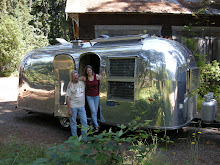 We spent a couple of days with our friends Jennifer & Michael in the lovely but sometimes sulfurous town of Steamboat Springs. Here the hot water bubbles out of the ground and in addition to the large Hot Springs Resort downtown, there are a number of natural hot springs in the area as well. Jennifer & Michael took good care of us as we worked laboriously to catch up on the website and blog. When you are traveling nearly every day, it can be hard to get some writing done!
We spent a couple of days with our friends Jennifer & Michael in the lovely but sometimes sulfurous town of Steamboat Springs. Here the hot water bubbles out of the ground and in addition to the large Hot Springs Resort downtown, there are a number of natural hot springs in the area as well. Jennifer & Michael took good care of us as we worked laboriously to catch up on the website and blog. When you are traveling nearly every day, it can be hard to get some writing done!While we were there, we got a chance to meet with Andy Cadenhead who is a Timber Management Specialist with the U.S. Forest Service in Steamboat. In every state we have been in since our departure, we have seen the ravaging effects the Mountain Pine Beetle is having on the Lodgepole Pine forests. In many areas stretching from Oregon to Colorado, the Pine Beetle has severely damaged or in many cases destroyed vast tracts of Lodgepole Pines. We wanted to learn more about the cause of this epidemic, as well as the short and long term consequences. Andy was an excellent resource for this information, and we spent about an hour with him one afternoon. This turned out to be a somewhat long but interesting story, so I am going to break it into several blogs.
For those of you who have not seen a forest affected by this, let me tell you, the sight is both shocking and depressing. Where once stood miles and miles of beautiful green trees, now stands a dead or dying forest that first turns red as the pine needles begin to die, then ultimately just becomes a bunch of dead tree trunks waiting to either blow down in the wind, or turn into a raging inferno when they catch fire.
Our first questions centered on how and why this current epidemic has gotten so devastating. We quickly found out that the Pine Beetle is not an invasive species, and that it has coexisted with the pine forests here for as long as anyone knows. In a healthy forest, it helps kill of the weaker trees so that the healthy may proper. It is only when the pine forests become distressed that the beetle will get out of hand and cause this kind of wide spread destruction. Historically, there have been periodic increases in the population resulting in some damage every 20 or so years. This time things have taken on a new dimension, and the scope of the kill is without precedent in modern times. The causes of this are not completely understood, but here are some of the things that are believed to have contributed.
First, in the early 1860's, and then again around 1879, there were some very large fires in some of the pine forests of the western U.S. It is unknown what triggered these fires, but it could have been the result of a previous beetle kill leaving large tracts of dead forests. At any rate, this resulted in large areas of deforestation, and eventually reforestation all occurring in a relatively short time frame. As pine trees begin to become mature at around 80 years, and then ripen into old age around 120 years, they become more susceptible to the beetle. With large tracts of trees all maturing around the same time, as opposed to the more natural mix of young and old trees, these forests become a breeding ground for the beetle which is normally kept in check by the healthier young trees and the cold winters.
Next over the last decade came some long periods of drought. The trees natural defense against the beetles is sap, which they produce at the points where the beetles enter the bark in an attempt to drive them out. For a healthy tree, this is usually enough to keep the beetles at bay so they do not end up killing the tree. However under drought conditions, the tree is not able to produce enough sap to stop the beetles, and in its already weakened state becomes a target.
And lastly, a series of mild winters, triggered perhaps by the effects of global warming, reduced the normal mortality rate for the beetles by 1-2% resulting in more larvae making it to mature beetles, which then have more offspring and so on.
The combination of these three factors, plus perhaps some of which we do not have a clue, resulted in the perfect storm. The pine beetle population has skyrocketed, and the stressed forests are falling victim. Everywhere we go, and in some areas as far as the eye can see, the red forests stand as a grim reminder.
Next-The Worst is Yet to Come




No comments:
Post a Comment